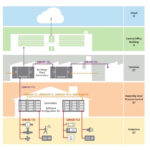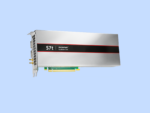The 802.3cg Ethernet standard uses a single pair of wires, and it manages data flow without switches, making it suitable for industrial networks at a lower cost than traditional Ethernet. Industrial plants have long used digital data to monitor and control their production facilities. Networks in factories, data centers, and commercial buildings push the edges…
Networking
What are some disadvantages of unshielded twisted pair cable?
Contributed by Frances Richards Unshielded twisted pair (UTP) cable is comprised of anywhere from two to 1800 unshielded twisted pairs of 100-ohm copper encased in an outer plastic jacket. This widely used data communication cable is most commonly found in local area networks (LANs) for applications such as computer networking, telecommunications, and Ethernet networks. Benefits […]
How does a 224 Gbps-PAM4 connector work?
Designing 224 Gigabits per second four-level pulse amplitude modulation (224 Gbps-PAM4) interconnects is challenging. But it’s required to support the demands of generative artificial intelligence (AI), machine learning (ML), 1.6 Terabits per second (Tbps) networking, and other high-speed applications in advanced data centers, as well as 5G and 6G communications infrastructure. At these elevated data…
What is the MIPI I3C HCI good for?
The mobile industry processor interface (MIPI) improved inter-integrated circuit (I3C) host controller interface (HCI) provides a scalable, low-power, medium-speed, two-wire I3C utility and control bus interface for connecting peripheral devices to application processors in smartphones, computers, Internet of Things (IoT) devices, automotive systems, and similar applications. MIPI I3C HCI supports faster design times for applications […]
How do SFP, SFP+, and QSFP compare?
Pluggable modules come in many variants, each designed for a specific purpose. Small form factor pluggable (SPF) technology was developed to support high-speed interconnects between servers, storage, and communications equipment in data centers and similar environments. Over time, the multi-source agreement (MSA) that specifies SPF has evolved to include new formats, including SFP, SFP+, SFP28,…
The first non-cellular 5G standard: DECT NR+
Officially known as DECT-2020 NR, the protocol brings 5G to smart devices over non-cellular networks. Learn more from a video interview with Jussi Numminen of Wirepas and vice-chair of the ETSI DECT technical committee. For several years, we’ve been hearing about the three points of 5G: enhanced mobile broadband (eMBB), massive machine-type communications (mMTC), and…
How many PCIe card sizes exist today, and where are they used?
There are five standard sizes for PCIe cards and two sizes of mini PCIe. In addition, some larger PCIe slots can accommodate more than one card using a process called bifurcation. This FAQ looks at the five standard sizes and common uses for them. Then turns to mini PCIe and its applications and closes with […]
OCXO holds network timing for up to eight hours
SiTime Corporation announced the SiTime Epoch Platform, designed to solve the most complex timing issues in electronics and disrupt 100-year-old quartz-based technology. The SiTime Epoch Platform is a MEMS-based, oven-controlled oscillator (OCXO) that delivers an ultra-stable clock to data center and network infrastructure equipment, unlocking a cumulative $2 billion served addressable market (SAM) in the next decade.…
Signal generator tests 5G FR1, LTE, Wi-Fi components and systems
Designed for bench and production use, the N5186A generates wireless signals to 3 GHz, 6 GHz or 8.5 GHz depending on model. Designing commercial or military wireless receivers, amplifiers, and systems means you’ll need to generate test signals. Keysight’s N5186A MXG vector-signal generator (datasheet) is available in one-channel or four-channel models with Type-N connectors. Each…
Monitor and analyze 5G network core interfaces
GL Communications Inc. addressed the press regarding their new 5G protocol analysis tool. GL’s 5G Protocol Analyzer enables real-time monitoring and capture of 5G network traffic, allowing you to effortlessly gather and analyze data across the network. The 5G Protocol Analyzer is an optional application for PacketScan. PacketScan is a protocol analysis software supporting a large range…











